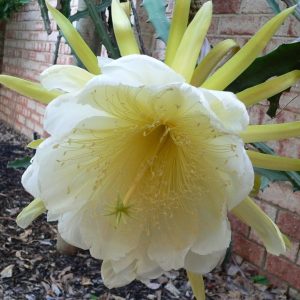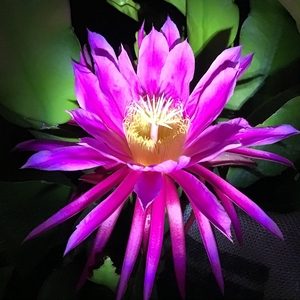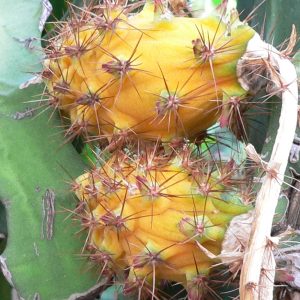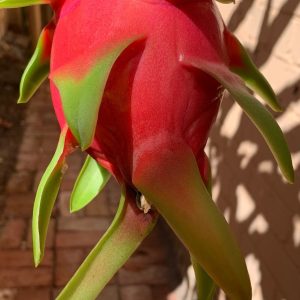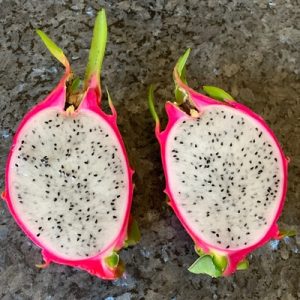Selenicereus (Hylocereus) spp
Pitaya, pitahaya, dragon fruit
Information given here focusses on the three main climbing cacti grown for fruit that are most readily sourced in WA: Selenicereus undatus (white-flesh, red skin species, WR), S. monacanthus, formerly H. polyrhizus (red-flesh, red skin, RR) and S. megalanthus (white-fleshed, yellow-skinned, WY).
Origin
Native to Meso-America, including the Caribbean Islands. Now grown in many areas of Asia and elsewhere. WR and RR are diploid but WY is a tetraploid cross of 2 other species. Inter-species and even inter-genera crosses are widespread, resulting in plants that are very heterozygous.
Climate
Sub-tropical to tropical rainforests up to 1800m elevation and rainfall of 350-2000mm pa. Optimal temperature range is 21-29°C; temperatures above 40-45°C and frosts are damaging. Excessive rain leads to flower drop and fruit rot. Although they are very drought tolerant, best yields are obtained with regular moisture as photosynthesis may decrease by 90% after only a week of water stress.
Plant Description
This understory genus with a shallow but efficient root system has a vine-like climbing habit supported by surrounding trees or by trellises/posts. The succulent green and photosynthetic stems and branches, 2.5-5cm wide, have 3 flanges or ribs, spines instead of leaves and aerial roots. The spines occur in clusters of 1-5 (areoles) spaced 4-6cm apart along the stem edges. Selenicereus use CAM metabolism for photosynthesis, making them extremely efficient in water use and able to survive under dry and arid conditions.
Relatives
Cactaceae family. There are many other fruit-producing cacti: columnar, tree-like, creeping, shrubby or small globular, but the principal ones are Opuntia (cactus or prickly pear) and Cereus. Considerable polymorphisms are seen in Selenicereus, with variations in flowers, stem and fruit contributing to difficulties in taxonomy. The family consists of 120-125 genera and approx. 1600 species.
Soils
Fertile soils are best but will still grow although with lower yields in very unfertile soils. Most cacti do not tolerate soil salinity well. There is a positive response in growth to the amount of organic matter in the soil.
Propagation
Seeds or vegetatively. Almost any part of a cactus will regenerate a plant. Seeds are essentially only used for breeding experiments.
Cultivars
There are many different varieties with different characteristics. Some have local names.
Flowering and Pollination
The large and beautiful fragrant white flowers, up to 30cm long and wide, open for one night only usually from spring to late autumn. They open just before sunset and close just after sunrise. There are numerous stamens on a slender anther stalk and an unusually large style up to 20cm long. The stigmas have 24 slender creamy green lobes. WY is generally more selffertile than the other two. Pollination is primarily by moths, bats, bees and maybe ants. If all else fails, try hand pollination.
Cultivation
These species grow well in shaded conditions necessary to avoid stress responses with extreme sunlight and heat. They will become large, heavy vines that require a substantial support like a tree, a wall, a post or a purpose-built trellis. Avoid working the soil near the plants, to protect the shallow roots. Flower induction is enhanced with reduced watering during winter and spring but thereafter good moisture levels should be maintained. Even under similar conditions and management, there is large variation in propensity of flowering and fruiting between varieties. They respond to regular fertilizer, particularly N and K, either by foliar or soil administration. Micronutrients may need attention, especially in alkaline soils.
Wind Tolerance
Given good support, they fare well. Pieces may break off.
Pruning
Carry out regular inspections and remove excess and old growth. Post-harvest pruning encourages the growth of new young shoots that wil bear flowers the following year.
The Fruit
Fruits are ovoid, WR and RR 10-15cm long X 10cm wide with WY less than half this size. WR and RR have attractive green, yellow or pinkish pointed scales, 2.5mm long, around the periphery with hundreds of small edible black seeds in the pulp. WR and RR fruits can weigh up to 800g, WY up to 350g. The latter have a higher sugar level and are usually sweeter than the other two. There are spines on WY fruit but these either abscise or can be easily rubbed off when mature. Fruit size is related to the effectiveness of pollination and seed number, and flesh weight is about 70% of the whole fruit. There is a reasonable level of vitamin C and antioxidants.
Fruit Production and Harvesting
Cropping with cutting-grown plants may begin within 2 years and yield will steadily increase over the next several years. WR and RR fruits begin to ripen 4-5 weeks after flowering; WY may take 12-20 weeks. WY yield is less than for the other two. Cropping is staggered over some months, suiting the home grower. For full flavour as a non-climacteric fruit they are best picked when fully coloured; this is compromised if insufficiently mature.
Fruit Uses
They have a delicate texture, and good varieties are delicious eaten fresh or after chilling by simply cutting them in half and spooning out. They’re also dried or frozen (they can be frozen whole) and used in ice creams, fruit salads, purees, jams and marmalades. The sugar/acid ratio is typically high, so addition of some lemon juice may improve taste for some people. Storage life at 10°C is about 14 days.
Pests and Diseases
In Australia, birds, possums, rats, or bats may be the main cause of any problems.
Comments
Fruits are most attractive and marketers say this is the main selling feature. But they’re more than that – very productive in our dry climate provided you give them a shade screen for our very hot high radiation summer weather. Strong support is needed as over the years they become quite heavy. Try and obtain cuttings from plants you know to be tasty and relatively self-fertile. With WR and RR plants, different varieties will assist cross-pollination but for top yields you might still need or wish to hand-pollinate.
Be aware that other species of edible cacti fruit can be called ‘pitaya’.
More Information
Pitaya fruiting for you?
Pitayas (Selenicereus spp) are climbing understory members of the cactus family, endemic to the Neotropics where the climate is humid and wet tropical/sub-tropical, without frosts, high temperatures or low humidity. Growing them in the Perth region presents a challenge, but one that can be overcome with appropriate care. The Israelis have been leaders in pomological research on the species for decades, and they’ve shown it’s possible to produce very high yields in arid desert conditions more unfavourable than ours.
Plant Selection
The three main commercial species worldwide are S. undatus (white flesh, red skin, WR), S. monacanthus (red flesh, red skin, RR) and S. megalanthus (white flesh, yellow skin, WY); the first two are much larger than the last and probably the ones you’ve seen in retail outlets and are most familiar with. All three have varying degrees of selfincompatibility, and all are capable of cross pollinating and fertilising one another. As a result, some plants sold in retail outlets are actually hybrids of varying degrees. On average with the three, WY is the most self-fertile, WR less and RR much less. The large flowers open for one night only, so natural pollinators are moths and other nocturnal animals. However flowers can open 1-2 hours before sunset and may remain open for similar times after sunrise (longer if a cool day), so if conditions are suitable for bees to forage, they can also contribute. This contribution can be significant with WY as the stigma and anthers are close together and compatible with bee size and behaviour, but is less so with WR and RR as these organs can be cms apart. In some countries and regions, suitable pollinators are not present in sufficient numbers and hand-pollination is always necessary to achieve meaningful yields.
There’s a lot of heterogeneity in Selenicereus, so different clones of the same species (they’re mainly propagated asexually by cuttings) can differ enough genetically to achieve adequate fertilisation when crossed. The probability of this being achieved is about 10%. Crosses between two of the three species ensure adequate genetic difference, fertilization and good fruit set provided sufficient pollen transfer is achieved either naturally or by hand. The resulting fruit are generally larger than crosses within clones for WR and RR, but usually smaller and less satisfactory when crossed with WY; WR and RR are both diploid and WY is tetraploid. The problem in planting several vines of only WR or RR is the uncertainty whether cross-pollination will be effective during the time you put into growing them, with failure being likely where plants all come from the same source. Deliberately planting a mix of both WR and RR overcomes this, and a further benefit is many F1 hybrids are sweeter than the parents.
If you’re only going to plant one vine, WY will give you the best odds of getting fruit. They’re sweeter than the other two but much smaller, and many people are put off by the sharp spines. However when fruit are mature these can be easily brushed off before picking. If you only grow a single WR or RR plant you could be lucky with it being relatively self-fertile, but the odds are against you. Even if you plant several WR or RR you may struggle to get many fruit.
Young Plant Establishment
You should select a place in your garden where vines will not be exposed to full sunlight, heat and dry conditions during our warmer months. Ideal mean temperatures are 20-30°C. If this is not addressed, the plant switches activity away from reproduction to survival mode and yield declines several-fold; stem sections will bleach and rot when conditions are severe. If you don’t have a suitable place that naturally provides some shade and a suitable microclimate, then you should consider using shade cloth with 30-40% radiation block.
In commercial orchards, there are two main support methods for the vines to climb on – a sturdy post with a horizontal section at the top, and a trellis system both about 1.5-2m high. Two or three plants are placed around each post and trained to grow straight to the top by removing lateral growth, with further growth and branching then allowed to hang down from the horizontal support. With a trellis, they can be placed 2-3m apart along the trellis, with similar training to the top before becoming pendant. The horizontal support should be of sufficient gauge (ie not a wire) to avoid cutting into the delicate stems that hang downwards. Supports need to be strong enough to carry loads that may be greater than 50kg/plant when mature (I learnt this the hard way). If well managed, pitayas grow rapidly and can start flowering/fruiting in their second year. Like all fruit trees, non-vertical stems have greater reproductive potential than vertical. So it’s the pendant stems where you’ll mainly get your fruit, and you need to always manage your plants to generate these. Leaves in pitaya are reduced to spines, small with WR and RR and longer with WY.
Management
In their native environment, rainfall can be more than 2000mm pa. However they cope quite well with drought conditions by drawing on water stored in their succulent stems, and they usually won’t die unless it’s for an unduly long period as they’re very efficient users of water. But like many other hardy plants (eg olives), if you want good fruit yields you have to provide fertile conditions and adequate water, plus in this case good drainage. A little often enough to keep the topsoil moist is better than the occasional heavy soaking as they have a shallow root system and are unable to take up water from deeper levels. Mulches and good soil organic and clay content will help achieve this relatively constant moisture level.
Like water, fertilisers should be little and often. Israeli studies have shown NPK ratios of 11, 2.5, 28 are best, with approximately twice the application rate during flowering and fruiting compared to vegetative periods. As plants are quite sensitive to salinity, do a check if using bore water. Flowers and fruit are borne on new growth, so as with other fruit species in this situation, pruning after harvest each year will encourage fruitful new growth for the following season. Learn to recognize the different shape of vegetative and reproductive buds to see whether you’re nudging plants in the desired fruitful direction – vegetative buds are slim/pointed and reproductive plump/rounded.
Under ideal conditions you can obtain one or other of these at each node ie where the spines/areoles are. By planting both WR and RR together, perhaps also with some genetic diversity within each species, you may get some fruit without having to hand pollinate. With all three species, fruit size is governed by how effectively each flower is pollinated/fertilised – the greater the number of seeds formed (which can be in the thousands) the bigger the fruit. Larger fruit are produced with hand pollination as fertilization is more complete given the less-than-efficient vectors we have. If you don’t have flower overlap at certain times you can store pollen in a sealed bag without loss of viability at 4°C for a few days and longer at -18°C. Flowers that have not been successfully fertilized reveal themselves quickly, with the basal scales next to the stem turning yellow and the whole flower falling off within 4-6 days of anthesis. The good ones remain green and the enclosed region closest to the stem will expand and grow rapidly. In their native environment, anthesis to harvest may be only 35 days. See if yours get near this with good management. Wait until fruit have developed full colour before picking as they’re a non-climacteric fruit and will not ripen further afterwards.
